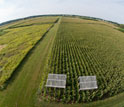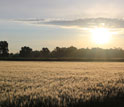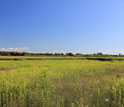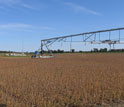News Release 12-133
Scientists Develop New Carbon Accounting Method to Reduce Farmers' Use of Nitrogen Fertilizer
Large amounts of nitrogen fertilizer lead to nitrous oxide, a greenhouse gas, in the atmosphere
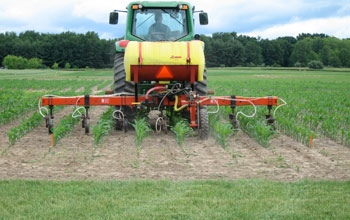
Agricultural crops are studied in experiments at NSF's Kellogg Biological Station LTER site.
July 18, 2012
This material is available primarily for archival purposes. Telephone numbers or other contact information may be out of date; please see current contact information at media contacts.
It's summer. For many of us, summer is a time synonymous with fresh corn, one of the major field crops produced in the United States.
In 2011, corn was planted on more than 92 million acres in the U.S., helping the nation continue its trend as the world's largest exporter of the crop.
Corn is a nitrogen-loving plant. To achieve desired production levels, most U.S. farmers apply synthetic nitrogen fertilizer to their fields every year.
Once nitrogen fertilizer hits the ground, however, it's hard to contain and is easily lost to groundwater, rivers, oceans and the atmosphere.
"That's not good for the crops, the farmers or the environment," says Phil Robertson, a scientist at Michigan State University and principal investigator at the National Science Foundation's (NSF) Kellogg Biological Station (KBS) Long-Term Ecological Research (LTER) site.
KBS is one of 26 such NSF LTER sites across the United States and around the globe in ecosystems from forests to coral reefs.
Nitrogen lost to the environment from agricultural fields is nitrogen not used by crops, Robertson says. "This costs farmers money and degrades water and air quality, with significant health, biodiversity and downstream economic effects."
Farmers already manage fertilizer to avoid large losses. But, to reduce losses further, it currently costs more money than the fertilizer saves.
Robertson and colleagues are working on a way to help make the time and expense of efforts to mitigate fertilizer loss worthwhile. They're putting the finishing touches on a program that would pay farmers to apply less nitrogen fertilizer in a way that doesn't jeopardize yields. The program, called the nitrous oxide greenhouse gas reduction methodology, is being conducted in partnership with the Electric Power Research Institute.
"This project is a great example of how long-term, fundamental research can contribute practical solutions to important environmental problems of concern in the U.S.--and ultimately around the world," says Matt Kane, an NSF program director for LTER.
In the United States, agriculture accounts for almost 70 percent of all nitrous oxide emissions linked with human activity. Nitrous oxide is one of the major gases contributing to human-induced climate change; it has a lifetime in the atmosphere of more than 100 years. In addition, a molecule of nitrous oxide has more than 300 times the heat-trapping effect in the atmosphere as a molecule of carbon dioxide.
In soils, the production of nitrous oxide through microbial activity is a natural process. By applying large amounts of fertilizer, however, humans have greatly increased the amount of nitrous oxide in soils. This is particularly true when nitrogen fertilizer is added in larger amounts than the crop needs, and when it is applied at times or in ways that make it difficult for the crop to get the full benefit.
"Improving the efficiency of nitrogen use for field crop agriculture holds great promise for helping mitigate climate change," Robertson says.
The nitrous oxide greenhouse gas reduction methodology, which is a way for farmers to participate in existing and emerging carbon markets, recently was approved by the American Carbon Registry and is in its final stages of validation by the Verified Carbon Standard--two carbon market standards that operate worldwide.
When farmers reduce their nitrogen fertilizer use, they can use the methodology as a means of generating carbon credits. These credits can be traded in carbon markets for financial payments.
The scientific underpinning for the methodology rests on decades of research Robertson and colleagues have conducted at the KBS LTER site.
"By closely following nitrous oxide, crop yields and other ecosystem responses to fertilizers," Robertson says, "we discovered that nitrous oxide emissions increase exponentially and consistently with increasing nitrogen fertilizer use."
The idea of the methodology is to offer ways of using less fertilizer to produce crops. But if farmers apply less fertilizer, will their crop production take a hit?
"Carbon credits provide an incentive to apply fertilizer more precisely, not to reduce yields," says Robertson. "If yields were reduced significantly, the climate effect would be nil because a farmer somewhere else would have to use more nitrogen to make up the yield loss, thereby generating more nitrous oxide."
The new methodology developed at NSF's KBS LTER site was successfully used by a Michigan farmer in Tuscola County as part of a proof-of-concept project.
"A major value of the approach is that it is straightforward to understand and implement," says KBS LTER scientist Neville Millar, who co-led development of the methodology.
In addition to providing an economic incentive, the methodology is a tool farmers can apply to enhance their land stewardship.
"The same strategies that farmers can use to minimize nitrous oxide loss will act to reduce the loss of nitrate to groundwater and loss of other forms of nitrogen to the atmosphere," says Millar.
Adam Diamant, technical executive at the Electric Power Research Institute and a co-developer of the methodology, says the new approach resulted in a "quadruple win: for farmers, for industrial organizations that may be required to reduce their greenhouse gas emissions, for the atmosphere and for water quality from the upper Midwest all the way to the Gulf of Mexico."
Adds Robertson: "We're in uncharted territory with a growing global human population and unprecedented environmental change.
"Performing the research that links environmental benefits to environmental markets, without compromising crop yields, is crucial for feeding more people while sustaining Earth's ecosystems."
-NSF-
-
Scientists at the KBS LTER site research agriculture and climate change.
Credit and Larger Version -
An aerial view of agriculture experiments at the Kellogg Biological Station.
Credit and Larger Version -
Dawn breaks over fields, some fertilized, some not, at the KBS site.
Credit and Larger Version -
Research on fields in all stages of ecological succession is conducted at KBS.
Credit and Larger Version -
Where does nitrogen fertilizer go? Studies of crops hold answers.
Credit and Larger Version
Media Contacts
Cheryl Dybas, NSF, (703) 292-7734, email: cdybas@nsf.gov
Related Websites
NSF LTER Network: http://www.lternet.edu
NSF Kellogg Biological Station LTER Site: http://lter.kbs.msu.edu/
The U.S. National Science Foundation propels the nation forward by advancing fundamental research in all fields of science and engineering. NSF supports research and people by providing facilities, instruments and funding to support their ingenuity and sustain the U.S. as a global leader in research and innovation. With a fiscal year 2023 budget of $9.5 billion, NSF funds reach all 50 states through grants to nearly 2,000 colleges, universities and institutions. Each year, NSF receives more than 40,000 competitive proposals and makes about 11,000 new awards. Those awards include support for cooperative research with industry, Arctic and Antarctic research and operations, and U.S. participation in international scientific efforts.
Connect with us online
NSF website: nsf.gov
NSF News: nsf.gov/news
For News Media: nsf.gov/news/newsroom
Statistics: nsf.gov/statistics/
Awards database: nsf.gov/awardsearch/
Follow us on social
Twitter: twitter.com/NSF
Facebook: facebook.com/US.NSF
Instagram: instagram.com/nsfgov

